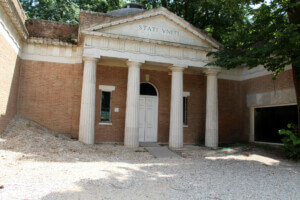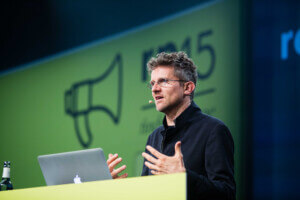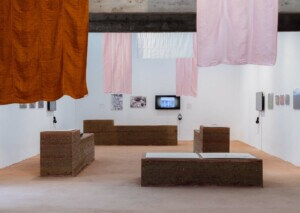At this year’s Venice Biennale, the title and theme “Reporting from the Front” charges architects from around the world to present projects that “make a difference” on the front lines of the world’s current challenges. A range of topics—refugee immigration, militarized space, social housing, spaces of education, and more—are addressed throughout the show. Though the discussion varies, one concept seems to pervade the show: the novel or uncommon use of materials.
The study of material usage isn’t outside normal architectural practice. However at this particular Biennale, the conversation surrounding materials, form, and space is taken to an extreme. This is most prevalent throughout the portion of the show that is specifically curated by head curator Alejandro Aravena. The central pavilion and the Arsenale, the two major spaces of Aravena’s show, are filled with projects that present the literal physicalness of materials.
This focus on materials is first evident in the main entrances of both spaces. To discuss waste, and take an inward look at the Biennale itself, Arevena reconfigured thousands of pounds of plasterboard and steel studs from the 2015 Art Biennale. The plasterboard was broken and staked into masonry-style walls; the steel studs hang on end from the ceiling.
Continuing into the central pavilion, the space opens up to reveal a soaring brick masonry arch by Paraguay-based Solano Benítez. Rather than a typical brick arch, the bricks were configured into thin members, giving the arch a lightness and seeming fragility. Subsequent rooms engage other materials in similarly unconventional ways. Epic bamboo structures and living plant walls are presented by Colombia-based Simón Vélez and Vietnam-based Vo Trong Nghia, respectively. In an exhibit entitled Mud Work! by Germany-based Anna Heringer, a full scale mud structure is built in the center of the gallery.
The material studies continue into the Arsenale. As with a handful of other projects, China-based Wang Shu looks at local and traditional building technologies in a series of brick and tile vignettes. International building consultants Transsolar’s contribution is completely composed of light and a thin vail of artificial fog. An entire space is dedicated to a series of sunlight beams coming through the roof of the building into the dark space. Polish architect Hugon Kowalski works in a material nearly polar opposite of Transsolar’s in his garbage and trash-filled exhibit.
In more than one case, small structures are built with board-form concrete or simply stacked bricks. Metal scaffolding is utilized in multiple exhibits as well. As a whole, the show is decidedly tactile. There is a great deal to touch and many spaces have a decidedly strong, yet not necessarily unpleasant, smell. Though not completely devoid of models and drawings, most of these typical modes of representation are presented in the National Pavilions, of which Aravena has much less influence.
The significance of this strong emphasis on material practices could be read in many ways. Without a frame of reference outside the exhibition, visitors might focus on a proliferation of traditional building techniques and materials. Considering a broader context though, one could easily question the definition, and engagement, of what Aravena defines as the “front” of architectural issues around the world. If Aravena’s assessment is accurate, perhaps we should be expecting to see more and more architect-designed “vernacular” in the coming years.










